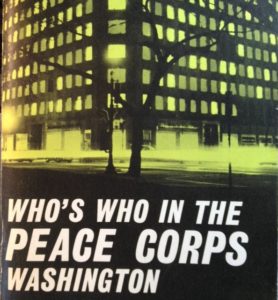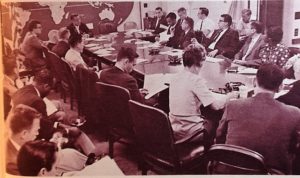Who’s Who in The Peace Corps Washington
The Peace Corps Washington Staff
 Simple addition would reveal that the Peace Corps administrators in Washington during its first years had lived abroad for a total of about four centuries. They had visited or stayed at length in every nation on earth.
Simple addition would reveal that the Peace Corps administrators in Washington during its first years had lived abroad for a total of about four centuries. They had visited or stayed at length in every nation on earth.
The cumulative lifetime travel mileage of the Washington staff added up to thirty or more round trips to the moon. One staff member all by himself use to log 150,000 miles a year as part of a former job. Such statistics are only mentioned because they indicate a familiarity with the broad world, an acquaintance with the far corners of the earth that were necessary in an agency that focused beyond the near horizon.
The Peace Corps staff in Washington, D.C. came from every possible background, from all economic levels, and from every part of the country. They included skiers, mountains climbers, big-game hunters, prizefighters, football players, polo players and enough Ph.D.’s (30) to staff a liberal arts college.
They included 18 attorneys, of whom only four continued to work strictly as attorneys in the General Counsel’s office. The rest (including Sargent Shriver) applied their lawyer’s mental disciplines to other activities of the Peace Corps.
The Peace Corps in Washington, in fact, was composed of people who showed all the individual differences that the first Volunteers did. Yet, like those Volunteers, they had one thing in common: they were working in the Peace Corps because that is where they wanted to be.
Figures from World War II indicated that 30 persons were required to support every soldier in the front lines. The Government’s peacetime overseas operations showed a more favorable ratio than the wartime figures—typically one person in Washington to every four overseas. The Peace Corps was organized in 1961 with the goal of ten Volunteers on the job for every administrative or clerical person in support, and that meant everyone—clerks, typists and overseas administrators.
In testimony before Congress, Sargent Shriver declared that his proposed ratio was skirting the edge of danger. He didn’t elaborate on what was obvious –that such a ratio was only possible at all because the support people in Washington tried to work as hard as the Volunteers did in their host countries.
To help inform the PCVs overseas, as well as, U.S. citizens who and what the Peace Corps was in terms of individuals and the agency, a booklet was written that was not printed or distributed at government expense, but did details the HQ Staff. All the photographs were taken by the first and youngest photographer at the agency in 1961, the award winning Rowland Scherman.
Over the next months, we will write about most of the first staff in Washington so that a lasting record will be established about the best and the brightest in Washington, D.C. during the early Sixties, the Peace Corps Administration at home and overseas.

No comments yet.
Add your comment